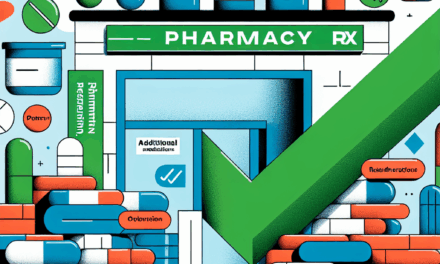Reviving Domestic Drug Manufacturing: How Technologists Are Responding to the Trump Administration’s Initiative
The landscape of pharmaceutical manufacturing in the United States has undergone significant changes in recent years, particularly in response to the Trump administration’s initiative to revitalize domestic drug production. This article explores the multifaceted approach technologists are taking to address the challenges and opportunities presented by this initiative. We will delve into the historical context, technological advancements, regulatory changes, economic implications, and the future of domestic drug manufacturing.
Historical Context of Domestic Drug Manufacturing
The United States has long been a leader in pharmaceutical innovation, but over the past few decades, there has been a marked shift towards outsourcing drug manufacturing to countries with lower labor costs, such as India and China. This trend has raised concerns about the reliability of drug supply chains, especially highlighted during the COVID-19 pandemic when shortages of essential medications became apparent.
In 2016, the U.S. Food and Drug Administration (FDA) reported that over 80% of active pharmaceutical ingredients (APIs) used in U.S. medications were sourced from abroad. This dependency on foreign manufacturing has led to vulnerabilities in the supply chain, prompting the Trump administration to take action. In 2020, the administration launched initiatives aimed at encouraging domestic production, including the “American Patients First” plan, which sought to lower drug prices and increase the availability of medications.
One of the key historical events that set the stage for this initiative was the 2008 financial crisis, which led to increased scrutiny of pharmaceutical pricing and supply chain practices. The opioid crisis further exacerbated these concerns, as it highlighted the need for more stringent regulations and oversight in drug manufacturing. The combination of these factors created a fertile ground for the Trump administration’s push to revive domestic drug manufacturing.
Technological Innovations in Drug Manufacturing
Technologists are at the forefront of the movement to revive domestic drug manufacturing, leveraging cutting-edge innovations to enhance production efficiency and reduce costs. Several key technologies are playing a pivotal role in this transformation:
- Continuous Manufacturing: Unlike traditional batch manufacturing, continuous manufacturing allows for the uninterrupted production of drugs. This method not only increases efficiency but also reduces waste and improves product quality. Companies like Vertex Pharmaceuticals have successfully implemented continuous manufacturing processes for their medications.
- 3D Printing: The advent of 3D printing technology has opened new avenues for personalized medicine. By enabling the production of customized drug formulations on-demand, 3D printing can address specific patient needs while minimizing inventory costs. Companies like Aprecia Pharmaceuticals are pioneering this technology in the pharmaceutical sector.
- Artificial Intelligence (AI): AI is being utilized to optimize drug development processes, from identifying potential drug candidates to streamlining clinical trials. By analyzing vast datasets, AI can predict drug interactions and efficacy, significantly reducing the time and cost associated with bringing new drugs to market.
- Biotechnology: Advances in biotechnology, including gene editing and monoclonal antibody production, are revolutionizing the way drugs are manufactured. Companies like Amgen and Genentech are leveraging these technologies to produce biologics that are more effective and have fewer side effects.
- Blockchain Technology: To enhance transparency and traceability in the supply chain, blockchain technology is being explored. This technology can help ensure that drugs are sourced ethically and that their quality is maintained throughout the manufacturing process.
These technological innovations not only improve the efficiency of drug manufacturing but also contribute to the overall goal of reducing reliance on foreign production. By investing in these technologies, U.S. companies can enhance their competitiveness in the global market while ensuring a stable supply of essential medications.
Regulatory Changes and Challenges
The revival of domestic drug manufacturing is not without its regulatory challenges. The FDA plays a crucial role in overseeing drug manufacturing practices, and any changes to regulations can significantly impact the industry. The Trump administration’s initiatives included efforts to streamline regulatory processes to encourage domestic production.
One of the key regulatory changes was the introduction of the Drug Competition Action Plan, which aimed to promote generic drug competition and reduce barriers to entry for new manufacturers. This plan included measures to expedite the approval process for generic drugs and increase transparency in drug pricing.
However, while these changes are intended to foster a more competitive environment, they also present challenges for manufacturers. For instance, the expedited approval process may lead to concerns about the thoroughness of safety and efficacy evaluations. Additionally, smaller manufacturers may struggle to meet the stringent regulatory requirements imposed by the FDA, which can be a barrier to entry in the market.
Moreover, the COVID-19 pandemic has prompted the FDA to adopt temporary measures to facilitate drug manufacturing, such as allowing for the use of alternative manufacturing sites and processes. While these measures have been beneficial in addressing immediate shortages, they raise questions about the long-term implications for regulatory oversight and product quality.
In response to these challenges, technologists and manufacturers are advocating for a balanced approach to regulation that encourages innovation while ensuring patient safety. Collaborative efforts between industry stakeholders and regulatory agencies are essential to create a framework that supports the revival of domestic drug manufacturing without compromising quality standards.
Economic Implications of Reviving Domestic Drug Manufacturing
The economic implications of reviving domestic drug manufacturing are profound, affecting not only the pharmaceutical industry but also the broader economy. The initiative has the potential to create jobs, stimulate economic growth, and enhance national security.
According to a report by the Pharmaceutical Research and Manufacturers of America (PhRMA), the U.S. pharmaceutical industry supports over 4.5 million jobs and contributes more than $1 trillion to the economy. By revitalizing domestic manufacturing, this initiative could lead to the creation of thousands of new jobs in manufacturing, research and development, and supply chain management.
Moreover, investing in domestic drug manufacturing can reduce the economic risks associated with reliance on foreign suppliers. The COVID-19 pandemic exposed vulnerabilities in global supply chains, leading to shortages of critical medications. By bringing production back to the U.S., companies can mitigate these risks and ensure a more stable supply of essential drugs.
Additionally, the revival of domestic manufacturing can enhance the competitiveness of U.S. companies in the global market. As countries around the world seek to bolster their own pharmaceutical industries, the U.S. must remain at the forefront of innovation and production capabilities. By investing in advanced manufacturing technologies and fostering a skilled workforce, the U.S. can maintain its leadership position in the global pharmaceutical landscape.
However, the economic benefits of reviving domestic drug manufacturing must be weighed against potential challenges, such as increased production costs. While domestic manufacturing can enhance supply chain resilience, it may also lead to higher prices for consumers. Policymakers must carefully consider these trade-offs to ensure that the initiative achieves its intended goals without placing an undue burden on patients and healthcare systems.
The Future of Domestic Drug Manufacturing
The future of domestic drug manufacturing is poised for transformation as technologists and industry leaders respond to the challenges and opportunities presented by the Trump administration’s initiative. Several key trends are likely to shape the landscape in the coming years:
- Increased Investment in R&D: As companies seek to innovate and develop new drugs, there will be a growing emphasis on research and development. This investment will not only drive advancements in drug manufacturing technologies but also lead to the discovery of new therapies that address unmet medical needs.
- Collaboration Between Industry and Academia: Partnerships between pharmaceutical companies and academic institutions will become increasingly important in driving innovation. By leveraging the expertise of researchers and technologists, companies can accelerate the development of new manufacturing processes and drug formulations.
- Focus on Sustainability: As environmental concerns continue to rise, there will be a growing emphasis on sustainable manufacturing practices. Companies will seek to minimize their environmental impact by adopting green technologies and reducing waste in the production process.
- Global Collaboration: While the focus is on reviving domestic manufacturing, global collaboration will remain essential. Companies will need to engage with international partners to share knowledge, resources, and best practices in drug manufacturing.
- Patient-Centric Approaches: The future of drug manufacturing will increasingly prioritize patient needs. Companies will explore personalized medicine and tailored drug formulations to ensure that treatments are effective and accessible to diverse patient populations.
In conclusion, the revival of domestic drug manufacturing is a complex and multifaceted initiative that requires collaboration between technologists, manufacturers, regulators, and policymakers. By leveraging technological innovations, addressing regulatory challenges, and considering economic implications, the U.S. can position itself as a leader in pharmaceutical manufacturing while ensuring a stable supply of essential medications for its citizens.
Conclusion
The Trump administration’s initiative to revive domestic drug manufacturing has sparked a wave of innovation and collaboration within the pharmaceutical industry. Technologists are responding by harnessing advanced manufacturing technologies, advocating for regulatory changes, and addressing economic challenges. As the U.S. navigates this transformative period, it is essential to strike a balance between fostering innovation and ensuring patient safety.
The future of domestic drug manufacturing holds great promise, with the potential to create jobs, enhance national security, and improve access to essential medications. By investing in research and development, fostering collaboration, and prioritizing sustainability, the U.S. can build a resilient and competitive pharmaceutical industry that meets the needs of its citizens.
Ultimately, the revival of domestic drug manufacturing is not just an economic imperative; it is a critical step towards ensuring the health and well-being of the American population. As we move forward, it is crucial to remain vigilant and proactive in addressing the challenges and opportunities that lie ahead.




